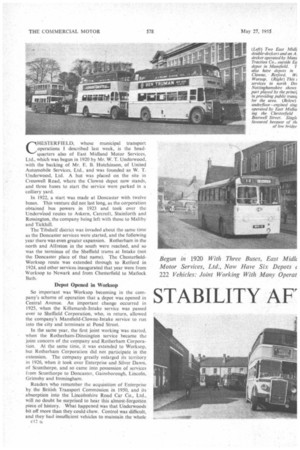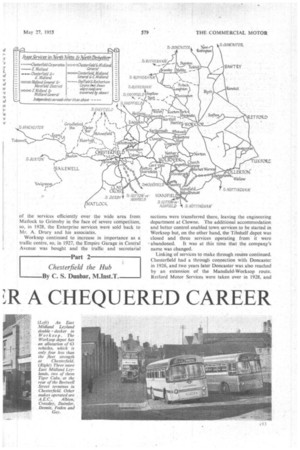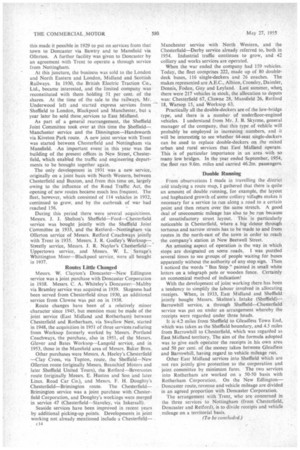STABILITY AFr A CHEQUERED CAREER
Page 52

Page 53

Page 54

If you've noticed an error in this article please click here to report it so we can fix it.
CHESTERFIELD, whose municipal transport operations I described last week, is the headquarters also of East Midland Motor Services, Ltd., which was begun in 1920 by Mr. W. T. Underwood. with the backing of Mr. E. B. Hutchinson, of United Automobile Services, Ltd., and was founded as W. T. Underwood, Ltd. A hut was placed on the site in Cresswell Road, where the Clowne depot now stands, and three buses to start the service were parked in a colliery yard.
In 1922, a start was made at Doncaster with twelve buses. This venture did not last long, as the corporation obtained bus powers in 1923 and took over the Underwood routes to Askern, Carcroft, Stainforth and Rossington, the company being left with those to Maltby and Tic khill.
The Tibshelf district was invaded about the same time as the Doncaster services were started, and the following year there was even greater expansion. Rotherham in the north and Alfreton in the south were reached, and so was the terminus of the Sheffield trams at Intake (not the Doncaster place of that name). The ChesterfieldWorksop route was extended through to Retford in 1924, and other services inaugurated that year were from Worksop to Newark and from Chesterfield to Matlock Bath. .
Depot Opened in Worksop
So important was Worksop becoming in the company's scheme of operation that a depot was opened in Central Avenue. An important change occurred in 1925, when the Killamarsh-Intake service was passed over to Sheffield Corporation, who, in return, allowed the company's Mansfield-Clowne-Intake service to run into the city and terminate at Pond Street.
In the same year, the first joint working was started, when the Rotherham-Dinnington service became the joint concern of the company and Rotherham Corporation. At the same dine, it was extended to Worksop, but Rotherham Corporation did not participate in the extension. The company greatly enlarged its territory in 1926, when it took over Enterprise and Silver Dawn, of Scunthorpe, and so came into possession of services from Scunthorpe to Doncaster. Gainsborough, Lincoln, Grimsby and Immingham. .
Readers who remember the acquisition of Enterprise by the British Transport Commission in 1950, and its absorption into the Lincolnshire Road Car Co., Ltd., will no doubt be surprised to hear this almost-forgotten piece of history. What happened was that Underwoods bit off more than they could chew. Control was difficult, and they had insufficient vehicles to maintain the whole
c 1 2 v
of the services efficiently over the wide area from Matlock to Grimsby in the face of severe competition, so, in 1928, the Enterprise services were sold back to Mr. A. Drury and his associates.
Worksop continued to increase in importance as a traffic centre, so, in 1927, the Empire Garage in Central Avenue was bought and the traffic and secretarial sections were transferred there, leaving the engineering department at Clowne. The additional accommodation and better control enabled town services to be started in Worksop but, on the other hand, the Tibshelf depot was closed and three services operating from it were abandoned. It was at this time that the company's name was changed.
Linking of services to make through routes continued. Chesterfield had a through connection with Doncaster in 1926, and two years later Doncaster was also reached by an extension of the Mansfield-Worksop route. Retford Motor Services were taken over in 1928, and this made it possible in 1929 to put on services from that town to Doncaster via Bawtry and to Mansfield via 011erton. A further facility was given to Doncaster by an agreement with Trent to operate a through service from Nottingham.
At this juncture, the business was sold to the London and North Eastern and London, Midland and Scottish Railways. In 1930, the British Electric Traction Co., Ltd., became interested, and the limited company was reconstituted with them holding 51 per cent. of the shares. At the time of the sale to the railways, Mr. Underwood left and started express services from — Sheffield to London, Blackpool and Manchester, but a year later he sold these services to East Midland.
As part of a general rearrangement, the Sheffield Joint Committee took over at this time the Sheffield— Manchester service and the Dinnington—Handsworth via Kiveton Park route. A new joint service with Trent was started between Chesterfield and Nottingham via Mansfield. An important event in this year was the building of the present offices in New Street, Chesterfield, which enabled the traffic and engineering departments to be brought together again.
The only development in 1931 was a new service, originally on a joint basis with North Western, between Chesterfield and Buxton, and from this time on, largely owing to the influence of the Road Traffic Act, the opening of new routes became much less frequent. The fleet, however, which consisted of 114 vehicles in 1932, continued to grow, and by the outbreak of war had reached 156.
During this period there were several acquisitions. Messrs. J. J. Shelton's Sheffield—Ford—Chesterfield service was bought jointly with the Sheffield Joint Committee in 1933, and the Retford—Nottingham via 011erton service of Messrs. Retford Coachways jointly with Trent in 1935. Messrs. J. R. Godley's WorksopStreetly service, Messrs. J. R. Naylor's Chesterfield-Uppertown service, and Messrs. W. L. Savages Whittington Moor—Blackpool service, were all bought in 1937.
Routes Little Changed
Messrs. W. Clayton's Doncaster—New Edlington service was a joint purchase with Doncaster Corporation in 1938. Messrs. C. A. Whiteley's Doncaster—Maltby via Bramley service was acquired in 1939. Skegness had been served from Chesterfield since 1930, an additional service from Clowne was put on in 1938.
Route changes have been of a relatively minor character since 1945, but mention must be made of the joint service (East Midland and Rotherham) between Chesterfield and Rotherham, via Swallow Nest, started in 1948, the acquisition in 1951 of three services radiating from Worksop formerly worked by Messrs. Portland Coachways, the purchase, also in 1951, of the Messrs. Glover and Bates Worksop—Langold service, and in 1953, those in the Mansfield area of Messrs. Baker Bros.
Other purchases were Messrs. A. Heeley's Chesterfield —Clay Cross, via Tupton, route, the Sheffield—New OlIerton route (originally Messrs. Beauchief Motors and later Sheffield United Tours), the Retford—Bevercotes route (originally Messrs. E. Huston and Son and later Lincs. Road Car Co.), and Messrs. F. H. Doughty's Chestcrfield—Brimington route. The ChesterfieldBrirnington service was a joint purchase with Chesterfield Corporation, and Doughty's workings were merged in service 47 (Chesterfield—Staveley, via Inkersall).
Seaside services have been improved in recent years by additional picking-up points. Developments in joint working not already mentioned include a Chesterfield—
(14 Manchester service with North Western, and the Chesterfield—Derby service already referred to, both in 1954. Industrial traffic continues to grow, and 42 colliery and works services are operated.
When the war ended the company had 159 vehicles. Today, the fleet comprises 2-22, made up of 80 doubledeck buses, 116 single-deckers and 26 coaches. The makes represented are A.E.C., Albion, Crossley, Daimler, Dennis, Foden, Guy and Leyland. Last summer, wher; there were 217 vehicles in stock, the allocation to depots was: Chesterfield 67,,Closvne 28, Mansfield 26, Retford 18, Warsop 15,and Worksop 63.
Practically all the double-deckers are of the low-bridge type, and there is a number of underfloor-engined vehicles. I understand from Mr. J. B. Skyrme, general manager of the company, that this type of Vehicle will probably be employed in increasing numbers, and it will be interestirig to see whether 44-seat single-deckers can be used to replace double-deckers on the mixed urban and rural services that East Midland operate. This is of particular importance in an area with so many low bridges. In the year ended September, 1954, the fleet ran 9.6m. miles and carried 46.2m. passengers.
'Double Running
From observations I made in travelling the district and studying a route map, I gathered that there is quite an amount of double running, for example, the layout and haphazard growth of some colliery villas makes it necessary for a service to run along a road to a certain point and then return over the same stretch. A good deal of uneconomic mileage has also to be run because of unsatisfactory street layout. This is particularly noticeable in Chesterfield, where a big detour through tortuous and narrow streets has to be made to and from routes in the north-east of the town in order to reach the company's station in New Beetwell Street.
An amusing aspect of operation is the way in which stops are designated on some roads. I was puzzled several times to see groups of people waiting for buses apparently without the authority of any stop sign. Then I noticed the words " Bus Stop" painted in small white letters on a telegraph pole or wooden fence. Certainly an economical method of indication!
With the development of joint working there has been a tendency to simplify the labour involved in allocating receipts. When, in 1933, East Midland and Sheffield jointly bought Messrs. Skelton's Intake (Sheffield)— Barrowhill service, a through Sheffield—Chesterfield service was put on under an arrangement whereby the receipts were regarded under three heads.
It is 4.2 miles from Sheffield to Gleadless Town End, which was taken as the Sheffield boundary, and 4.5 miles from Barrowhill to Chesterfield, which was regarded as East Midland territory. The aim of the formula adopted was to give each operator the receipts in his own area and 50 per cent. of the money taken between Gleadless and Barrowhill, having regard to vehicle mileage run.
Other East Midland services into Sheffield which are not run jointly give protection to the corporation and joint committee by minimum fares. The two services into Rotherham are worked on a 50-50 basis with Rotherham Corporation. On the New EdlingtonDoncaster route, revenue and vehicle mileage are divided in an agreed proportion with Doncaster Corporation.
The arrangement with Trent, who are concerned in the three services to Nottingham (from Chesterfield, Doncaster and Retford), is to divide receipts and vehicle mileage on a territorial basis.








































































































